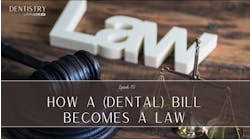by Robert Weller, DDS
Aging baby boomers value ways to preserve and enhance their natural dentition.
Copyright FPG International
For 20 years — starting around l980 — younger dentists would complain that they missed the "Golden Age of Dentistry" in the l950s and 1960s. Well, as one who was there and who can compare it with the present, I can tell you — without a doubt — that dentistry, as a profession, enjoys a more favorable social, economic, and demographic climate than ever before.
Around 1950, a post-World War II boom began in dentistry. Legions of school children, who grew up without the advantages of fluoridated water and fluoride toothpaste, flooded dental offices (then rightly called "waiting rooms") with their multiple carious lesions. The restorations of the day were amalgam for posterior teeth and silicate cement for tooth-colored anterior restorations.
In those days, dentists knew that the silicates eventually would dissolve away, but their high fluoride content permeated the tooth and prevented recurrent decay. Amalgams, on the other hand, were supposed to last forever. Patients would come into the office with a 20-year-old fractured amalgam protesting, "Doctor, your filling broke."
Changing expectations
Today, the desire for tooth-colored posterior restorations transcends any consideration of limited expectations for longevity of treatment. Even though we warn patients that tooth-colored composites may not have the durability of cast gold or amalgam, increasing numbers prefer tooth-colored, undetectable dentistry, whether direct composites, indirect composites, or porcelain.
Creative advances in both dental materials and techniques have given dentists expanded options for restoring teeth and enhancing smiles.
The perfect smile
A second paradigm shift has been a dramatic change in the public perception of the ideal smile. In the middle of the last century, everyone knew at least one person with full dentures. Unfortunately, many dentists at that time fabricated dentures with false teeth that were very obvious in appearance. The teeth would be lined up in a straight row, and they resembled a picket fence. Consequently, most patients were very concerned that their dental treatment not have a "denture look," meaning a straight, mechanical lineup of teeth.
Discerning consumers were apprehensive when a treatment plan was presented for anterior fixed or removable replacement teeth. Everyone knew someone whose porcelain jackets or veneer crowns had that "denture look."
Frush and Fisher, in a series of articles in the Journal of Prosthetic Dentistry from 1955 through 1959, presented organized protocols for creating attractive smiles with full dentures. Their principles still are being taught and applied to smile design today.
During aesthetic dentistry lectures that I presented in the 1970s (the term "cosmetic dentistry" had not yet been born), the emphasis was, in Dr. Frush's words, "to copy the disharmonies of nature in order to mask the artificiality of the restoration." Some of the most prominent leaders in cosmetic dentistry today were introduced to these concepts at my lectures in those early days.
Shunning the natural look
However, in a remarkable turn of events, we now have an ever-increasing number of older citizens and an ever-decreasing number of full denture-wearers. Rather than being apprehensive at the thought of their smile looking artificial, most patients today want the straightest, whitest smiles they can get, sometimes identifying with a movie or television star — i.e., "I want Regis Philbin teeth."
The paradox today is that we now are called upon to mask the disharmonies of nature in order to create the present fashion of the perfect smile — one that would formerly be scorned as looking too artificial!
The widespread adoption of bleaching and porcelain laminates by celebrities in the media — coupled with the national desire for instant gratification — has created a geometric increase in the demand for cosmetic dentistry. In increasing numbers, adult patients prefer a quick fix in porcelain to orthodontic therapy that otherwise might be recommended for them.
The ardent pursuit of enhanced appearance can be seen in every facet of our society. Plastic surgery procedures have proliferated from face lifts to remodeling of every area of the body for both men and women of all ages. Magazines that appeal to both sexes regularly feature cover stories on enhancing your image. The articles cover plastic surgery, dermatology procedures (dermabrasion and facial peels), cosmetic dentistry, new hairstyles, and designer clothes. The March/ April issue of Modern Maturity has a lengthy story on plastic surgery, and the article is featured on the cover.
It's easy to understand why appearance is so important today when older people are remaining in the workplace longer, frequently competing with younger colleagues. Also, with the divorce rate going through the roof, we have an increasing population of newly recycled singles trying to attract someone to love and be loved by.
Cosmetic dentistry is, in my judgment, the most cost-effective way to look younger and more attractive. Long after the plastic surgeon's efforts have sagged and the youthful fashions have gone out of style, well-executed cosmetic dentistry continues to look great. Patients who have had an introduction to smile enhancement — usually in the upper anterior region — frequently return to improve the appearance and occlusion in other areas of the mouth. They also are more focused on home care and regular office visits to the hygienist.
Demographic change
The third and most significant paradigm shift is the demographic change taking place in the age distribution of our population, coupled with a change in attitude by our current senior citizens — in reality, aging baby boomers!
When I married my wife 45 years ago, her grandmother walked around with her dentures in her pocket. She was about 65 years old and easily could have afforded the cost of new dentures. Instead, grandma repeated her mantra, "How can I justify having new teeth at my age? How long am I going to live?"
Fortunately, her granddaughter married a dentist, and 10 years after I made her a set of dentures, she was ready for a new set.
The contrast in attitude and life expectancy can be exemplified best by a recent experience I had with a new patient. At her initial exam, I noted the wear on this lovely lady's anterior teeth. She responded, "They ought to be worn — I've been using them for 80 years!" Even though I jokingly reminded her that those teeth didn't erupt until she was five-and-a-half, so she actually had used them for only 75 years, I nevertheless respectfully noted her reference to her age.
In outlining her treatment plan at her next visit, I told her: "Ordinarily, I might recommend three crowns for your dental treatment. But, out of deference for your age, which you brought up at our last visit, I would be happy to patch those three teeth up with some kind of filling if that's what you would like." "Oh no!" she responded. "I want those crowns!"
Several things have changed in the interim between grandma's refusal to get new dentures and today's senior citizens getting a full range of restorative and cosmetic dentistry.
The average man at 65 years of age has a life expectancy of 18 years. The average woman of 65 can expect to live another 23½ years to age 88. Because these are averages, that means that half of this group will live even longer.
Our current seniors know that they have a longer life expectancy. Most enjoy good health and, even more importantly, they enjoy a wonderful sense of entitlement and self-esteem. However, at times, we have to nudge our patients gently in the right direction.
For patients in middle age who continually procrastinate about starting necessary dental treatment, I have developed a program inspired by experience.
A universal theme
For patients who have no intention of retiring or relocating — or those who already are retired — I have borrowed a theme from a presentation I heard from a financial planner. This is relevant for all patients who are middle-aged or older. His advice to a couple nearing retirement age was not what I expected to hear. His recommendation was: "Travel ... don't wait until your body is too frail to take long trips and climb the Spanish Steps in Rome. Do it now because you are never going to be healthier than you are now."
Most mature people realize that good health is not a guaranteed continuum. Even the healthiest of mature people are aware of friends and family beset with unexpected illness. It makes common sense to do comprehensive restorative dentistry before medical problems make it more arduous.
The most wonderful paradigm shift in dentistry for older patients is that we now have a generation of people living well into their 80s with their own teeth. By acknowledging their increased life expectancy, patients in their 60s, 70s, and beyond are willing and eager to have dental treatment to preserve their teeth and appearance.
Patients and staff
The most important element in a typical successful practice is a patient's relationship with the entire dental team. In the past, if I heard my hygienist engaged in a lengthy conversation with a patient, I would bristle internally. Now, older and wiser, I realize that the hygienist's interaction with patients goes far beyond root-planing and X-rays. Not only do most patients regard their hygienist as a friend, but also as a confidante. Frequently, she is the first to hear about life-cycle events such as engagements, weddings, and retirement plans.
Time to smile
When a wedding is being planned, a great deal of emphasis is frequently placed on recording the celebration with both photography and video. This is an ideal time to discuss any treatment to enhance the smiles of the bride, groom, and/or members of the entire immediate families before the event is recorded for posterity. Suggested improvements can range from bleaching to porcelain veneers and, where indicated, replacement of missing teeth.
Many of the families who have been treated in our office for two or three generations have wedding albums that could serve as a catalog of super smiles. We are very much a part of our patients' lives. Staying attuned to their life-cycle needs is a win/win situation for all of us.
Learn from your patients
Sometimes, negative feedback can lead to very positive outcomes. The complaints from my retired patients in the Sunbelt started several years ago, and they all had a common theme. A typical phone call to my office sounded like the following:
"Dr. Weller, I'm living in sunny Florida now and just came back from the office of my new dentist down here." While looking through the chart of this former patient, I respond, "That's nice. I'm glad you're taking care of your teeth."
"But, Dr. Weller," comes the rapid reply, "he tells me that I need five crowns." "That sounds right. I told you the same thing at your last three hygiene appointments, but you wanted to wait." Then, a litany of reasons for remorse would follow.
"But, Dr. Weller, now I have to have this work done by a stranger. I would rather have had this treatment done in your office, where I was so comfortable for years. Also, now that I have stopped working, I'm on a fixed income." (No matter how much money they have, I frequently hear retired people lament about incurring expenses when they are on a fixed income.)
Frequently, there are two more verses in this postretirement lamentation:
"I wish you had convinced me to do it in your office. Now, I have no more dental insurance. Also, I'm not so healthy anymore, and it certainly would have been better to have had my treatment completed when I was feeling fit."
This feedback from a number of former patients has helped me shape a much better, more focused approach to treatment-planning for my patients, years before they retire.
When middle-aged patients put off necessary dentistry, I narrate the scenario I just related to you and suggest that we begin a "preretirement treatment plan," sometimes phasing treatment over several years. The response to this approach has been very positive.








